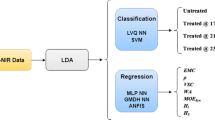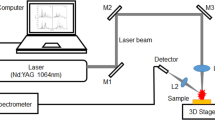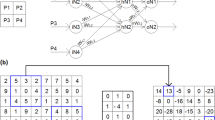Abstract
Species recognition and identification are very important in the wood industry. The identification of some tree species is complex when only the wood is available, often requiring multiple characterization techniques. In some instances, near-infrared spectroscopy can provide a method for the identification of wood species. However, as the amount of data acquired by near-infrared spectrometers are large, there is a need to use mathematical and computational tools to treat and analyze the data. This paper reports the results of testing an artificial neural network in comparison with SIMCA classification to identify some Brazilian wood species based on near-infrared spectra. The neural network developed did not result in any identification error for a margin of ±2% with the use of a spectral range from 4000 to 10,000 cm−1, while SIMCA produced more than 60% identification error with raw spectral data. The artificial neural network was more efficient than the SIMCA classification and has good potential to be applied for species discrimination.



Similar content being viewed by others
References
Adedipe OE, Dawsin-Andoh AB, Slahor J, Osborn AL (2008) Classification of red oak (Quercus rubra) and white oak (Quercus alba) wood using a near infrared spectrometer and soft independent modelling of class analogies. J Near Infrared Spectrosc 16(1):49–57
Bächle H, Zimmer B, Wegener G (2012) Classification of thermally modified wood by FT-NIR spectroscopy and SIMCA. Wood Sci Technol 46(6):1181–1192
Banerjee AK, Kiran K, Murty USN, Venkateswarlu C (2008) Classification and identification of mosquito species using artificial neural networks. Comput Biol Chem 32(6):442–447
Braga JWB, Pastore TCM, Coradin VTR, Camargos JAA, Silva ARD (2011) The use of near infrared spectroscopy to identify solid wood specimens of Swietenia macrophylla (CITES appendix II). IAWA J 32(2):285–296
Brunner M, Eugster R, Trenka E, Bergamin-Strotz L (1996) FT-NIR spectroscopy and wood identification. Holzforschung 50(2):130–134
Casale M, Schimleck LR, Espeyd C (2010) Classification of pernambuco (Caesalpinia echinata Lam.) wood quality by near infrared spectroscopy and linear discriminant analysis. J Near Infrared Spectrosc 18(6):435–442
Clark JY (2003) Artificial neural networks for species identification by taxonomists. Biosystems 72(1–2):131–147
Esteban LG, Fernández FG, Palacios PP, Romero RM, Cano NN (2009) Artificial neural networks in wood identification: the case of two Juniperus species from the Canary Islands. IAWA J 30(1):87–94
Fan Q, Wanga Y, Sun P, Liu S, Li Y (2010) Discrimination of Ephedra plants with diffuse reflectance FT-NIRS and multivariate analysis. Talanta 80:1245–1250
Hein PRG, Lima JT, Chaix G (2010) Effects of sample preparation on NIR spectroscopic estimation of chemical properties of Eucalyptus urophylla S.T. Blake wood. Holzforschung 64:45–54
Horikawa Y, Tazuru SM, Sugiyama J (2015) Near-infrared spectroscopy as a potential method for identification of anatomically similar Japanese diploxylons. J Wood Sci 61:251–261
Hwang SW, Horikawa Y, Lee WH, Sugiyama J (2016) Identification of Pinus species related to historic architecture in Korea using NIR chemometric approaches. J Wood Sci 62:156–167
Kang SH, Song SH, Lee SH (2012) Identification of butterfly species with a single neural network system. J Asia Pac Entomol 15(3):431–435
Kattmah G, Azim GA (2013) Fig (Ficus carica L.) identification based on mutual information and neural networks. Int J Imag Graph Signal Proc 5(9):50–57
Labati RD, Gamassi M, Piuri V, Scotti F (2009) A low-cost neural-based approach for wood types classification. In: CIMSA 2009—International conference on computational intelligence for measurement systems and applications, Hong Kong, China. doi:10.1109/CIMSA.2009.5069947
Lorenz C, Ferraudo AS, Suesdek L (2015) Artificial neural network applied as a methodology of mosquito species. Acta Trop 152:165–169
Ma MY, Wang GY, Huang AM, Zhang ZY, Xiang YH, Gu X (2012) Study on artificial neural network combined with near infrared spectroscopy for wood species identification. Spectrosc Spectr Anal 32(9):2377–2381
MMA (2008) Ministry of Environment. Normative Instruction 06, September 23, 2008. Brasília, Ministry of Environment. (In Portuguese)
Mouwen DJM, Capita R, Alonso-Calleja C, Prieto-Gómez J, Prieto M (2006) Artificial neural network based identification of Campylobacter species by Fourier transform infrared spectroscopy. J Microbiol Methods 67:131–140
Mu H, Zhang M, Qi D, Ni H (2015) The application of RBF neural network in the wood defect detection. Int J Hybrid Inf Technol 8(2):41–50
Muñiz GIB, Carneiro ME, Batista FRR, Schardosin FZ, Nisgoski S (2016) Wood and charcoal identification of five species from the miscellaneous group known in Brazil as “angelim” by near-ir and wood anatomy. Mad Ciencia y Tecnol 18(3):505–522
Nie M, Zhang WQ, Xiao M, Luo JL, Bao K, Chen JK, Li B (2007) FT-IR spectroscopy and artificial neural network identification of Fusarium species. J Phytopathology 155:364–367
Nisgoski S, Carneiro ME, Muñiz GIB (2015) Influencia de la granulometría de la muestra en la discriminación de especies de Salix por infrarrojo cercano (Influence of sample granulometry on discrimination of Salix species by near infrared). Mad Ciencia y Tecnol 17(1):195–204
Nisgoski S, Schardosin FZ, Batista FRR, Muñiz GIB, Carneiro ME (2016) Potential use of NIR spectroscopy to identify Cryptomeria japonica varieties from southern Brazil. Wood Sci Technol 50(1):71–80
Okan OT, Deniz I, Tiryaki S (2015) Application of artificial neural networks for predicting tensile index and brightness in bleaching pulp. Mad Ciencia y Tecnol 17(3):571–584
Ozsahin S (2012) The use of an artificial neural network for modeling the moisture absorption and thickness swelling of oriented strand board. BioResources 7(1):1053–1067
Packianather MS, Drake PR (2000) Neural networks for classifying images of wood veneer. Part 2. Int J Adv Manuf Technol 16(6):424–433
Pandolfi C, Mugnai S, Azzarello E, Bergamasco S, Mais E, Mancuso S (2009) Artificial neural networks as a tool for plant identification: a case study on Vietnamese tea accessions. Euphytica 166:411–421
Pastore TCM, Braga JWB, Coradin VTR, Magalhães WLE, Okino EYA, Camargos JAA, De Muñiz GIB, Bressan OA, Davrieux F (2011) Near infrared spectroscopy (NIRS) as a potential tool for monitoring trade of similar woods: discrimination of true mahogany, cedar, andiroba and curupixá. Holzforschung 65(1):73–80
Pham DT, Soroka AJ, Ghanbarzadeh A, Koc E, Otri S, Packianather M (2006) Optimising neural networks for identification of wood defects using the bees algorithm. In: 2006 IEEE International conference on industrial informatics, doi:1-4244-9701-0/06/$20.00 c_ 2006 IEEE
Rebuffo CA, Schmitt J, Wenning M, von Stetten F, Scherer S (2006) Reliable and rapid identification of Listeria monocytogenes and Listeria species by artificial neural network-based fourier transform infrared spectroscopy. Appl Environ Microbiol 72(2):994–1000
Russ A, Firesova M, Gigac J (2009) Preliminary study of wood species identification by NIR spectroscopy. Wood Res 54(4):23–32
Sandak A, Sandak J, Negri M (2011) Relationship between near-infrared (NIR) spectra and the geographical provenance of timber. Wood Sci Technol 45(1):35–48
Schwanninger M, Rodrigues JC, Fackler K (2011) A review of band assignments in near infrared spectra of wood and wood components. J Near Infrared Spectrosc 19(5):287–308
Simmonds EJ, Armstrong F, Copland PJ (1996) Species identification using wideband backscatter with neural network and discriminant analysis. ICES J Mar Sci 53:189–195
Sundaram M, Abitha J, Raj MM, Ramar K (2015) Wood species classification based on local edge distributions. Optik 126(21):2884–2890
Sussillo D, Barak O (2013) Opening the black box: low-dimensional dynamics in high-dimensional recurrent neural networks. Neural Comput 3(25):626–649
Tsuchikawa S, Siesler HW (2003) Near-infrared spectroscopy monitoring of the diffusion process of deuterium-labeled molecules in wood. Part I. softwood. Appl Spectrosc 57(6):667–674
Yonenobu H, Tsuchikawa S (2003) Near-infrared spectroscopic comparison of antique and modern wood. Appl Spectrosc 57(11):1451–1453
Zbiéc M (2011) Application of neural network in simple tool wear monitoring and identification system in MDF milling. Drvna Ind 62(1):43–54
Zhang W, Teng G, Wang C (2013) Identification of jujube trees diseases using neural network. Optik 124(11):1034–1037
Zhang X, Yu H, Li B, Li WJ, Li X, Bao C (2014) Discrimination of Pinus yunnanensis, P. kesiya and P. densata by FT-NIR. J Chem Pharm Res 6(4):142–149
Author information
Authors and Affiliations
Corresponding author
Rights and permissions
About this article
Cite this article
Nisgoski, S., de Oliveira, A.A. & de Muñiz, G.I.B. Artificial neural network and SIMCA classification in some wood discrimination based on near-infrared spectra. Wood Sci Technol 51, 929–942 (2017). https://doi.org/10.1007/s00226-017-0915-8
Received:
Published:
Issue Date:
DOI: https://doi.org/10.1007/s00226-017-0915-8




